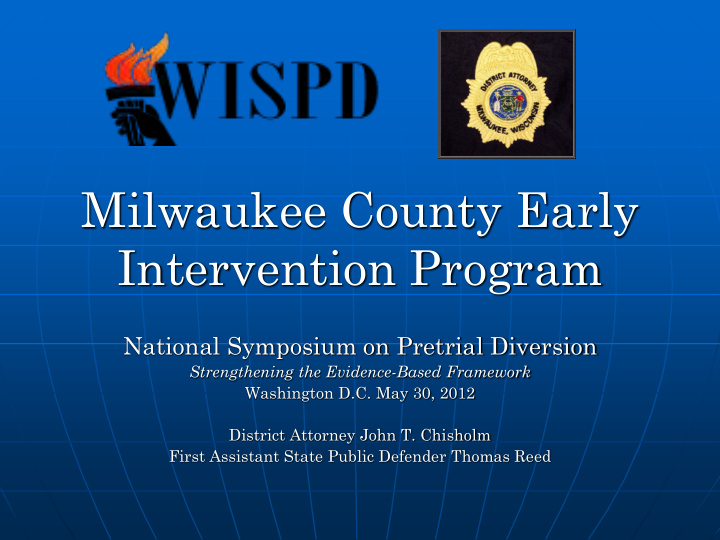



Milwaukee County Early Intervention Program National Symposium on Pretrial Diversion Strengthening the Evidence-Based Framework Washington D.C. May 30, 2012 District Attorney John T. Chisholm First Assistant State Public Defender Thomas Reed
2007 Milwaukee Program Small group of Assistant District Attorneys, Public Defenders, Defense Attorneys and case workers met and identified a group of clients who did not need punishment as much as help to live a pro-social life. A small pilot program started in March of 2007 with no outside technical assistance. Developed a protocol outlining who would be offered a Diversion (pre-charge agreement) or a Deferred Prosecution Agreement (“DPA”)(post -charge agreement) and developed standard Diversion/DPA agreements which would be later tailored to the individual client’s needs.
Funding One small funding source which is called Treatment Alternative to Diversion Program (“TAD”). TAD provides an initial screen which is conducted by Justice 2000 (J2K), a pretrial service organization, to assist in understanding the needs and the risks of clients. Limited remaining money for case management
Process J2K agreed to monitor clients who were higher risk and had AODA problems or would monitor clients with significant mental health issues. District Attorneys Office and the Public Defenders Office went into the community and spoke to non- profit agencies that were already serving the same clientele to see if they would agree to monitor clients without receiving any money Each agreement includes non-mandatory $50 participant fee to offset costs If participant had only restitution, community service, and/or letter of apology as component of Diversion or DPA, than the Public Defender would monitor the agreements and provide proof of compliance.
Statistics From January 1, 2007 through December 31, 2010, J2K conducted TAD risk and needs assessment on 9,686 individuals and provided intensive case management services to 1,382 individuals. Of this group, 66.2% of the program participants successfully completed their DPA or diversion agreements and either had their charges dismissed, reduced or not filed at all. This group represents a savings of more than $72,000 jail and prison bed days. Within 3 Years, 2% who successfully complete TAD Diversion/DPA, reenter prison Within 3 Years, 8% who DO NOT successfully complete TAD Diversion/DPA, reenter prison University of Wisconsin School of Medicine and Public Health issued December 2011
Non-J2K Monitored Agreements The information gathered during the 9,686 TAD assessment led to an additional 1,027 individuals receiving a DPA/Diversion, but the agreements were monitored by other agencies. Within this group, 77% of individuals successfully completed their DPA/Diversion agreements. University of Wisconsin School of Medicine and Public Health issued December 2011
EBDMI Grant Community Justice Council, which consists of the major stakeholders in the criminal justice system, applied for the EBDMI grant in 2010. As part of the grant, received a great deal of technical assistance to help with the Early Intervention program. Quickly learned that the program was not evidence-based.
Challenges No clearly defined goal of the program Unclear if limited to clients with AODA/mental health issues Lack of consistency in obtaining an offer for diversion or DPA. The protocol was more specific on who did not qualify for DPA/Diversion then who did qualify. Diversion/DPA program was generally an offense based program as opposed to a long – term risk and needs program. Using the wrong tools - Using pretrial risk tool rather than long-term risk-need tool like LSI-R or Compass. Agreements did not address top criminogenic needs. Over-conditioning clients who were low-risk and sometimes under-conditioning high-risk clients.
Changes Through the EBDMI grant, are making changes to program. Currently working on a new Early Intervention programming document which outlines the eligibility criteria. Still prohibitions to the program — predominately violent offenses, but eligibility focuses more on the results of a long-term risk/need assessment. Added the LSI-R short (8 questions) to a Universal Screen that everyone receives within 24 hours of entering jail. Low-risk individual presumptively eligible for Diversion, assuming no prohibitions.
Changes Continued Moderate to high risk individuals presumptively eligible for DPA/Drug Treatment Court, assuming no prohibitions. Using only accountability strategies on diversions, not risk-reduction strategies, because we are dealing with low-risk offenders. For all clients who are not low-risk on the LSI-R short, they will be scheduled for a full LSI-R. Attempting to create a Central Liaison Office (CLO) that will look at the results of the LSI-R and determine the top 1-3 criminogenic needs which should be addressed in the agreement. The CLO will make referrals for treatment and will expect the treatment providers to play an active role in the agreement. The CLO will house the data on the program.
Changes Continued In the process of surveying treatment community to determine if they are providing evidence-based treatment and are trying to create a Preferred Provider Network of agencies that are evidence- based. Provide assistance to those agencies that want to be evidence-based so they can join the Preferred Provider Network. Currently attempting to clearly define violations, sanctions and incentives.
The GOAL The goal of Milwaukee County’s Early Intervention programs is to reduce long-term recidivism risk of individuals involved in the criminal justice system while at the same time ensuring public safety and the efficient allocation of limited criminal justice resources.
Recommend
More recommend